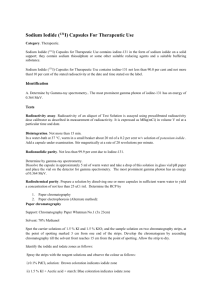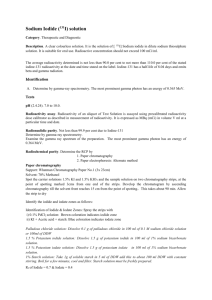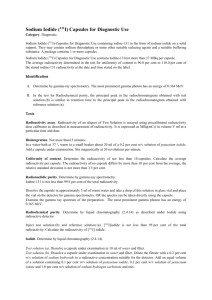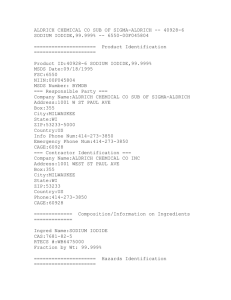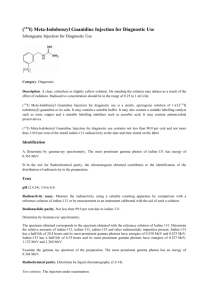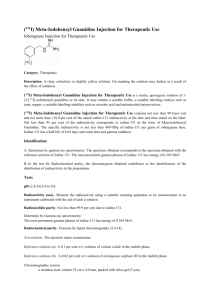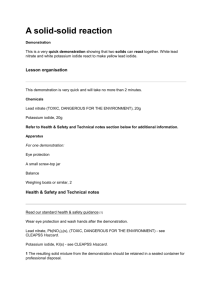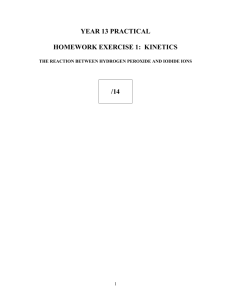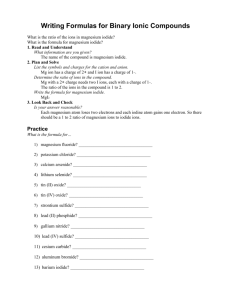Sodium iodide (131I) solution
advertisement
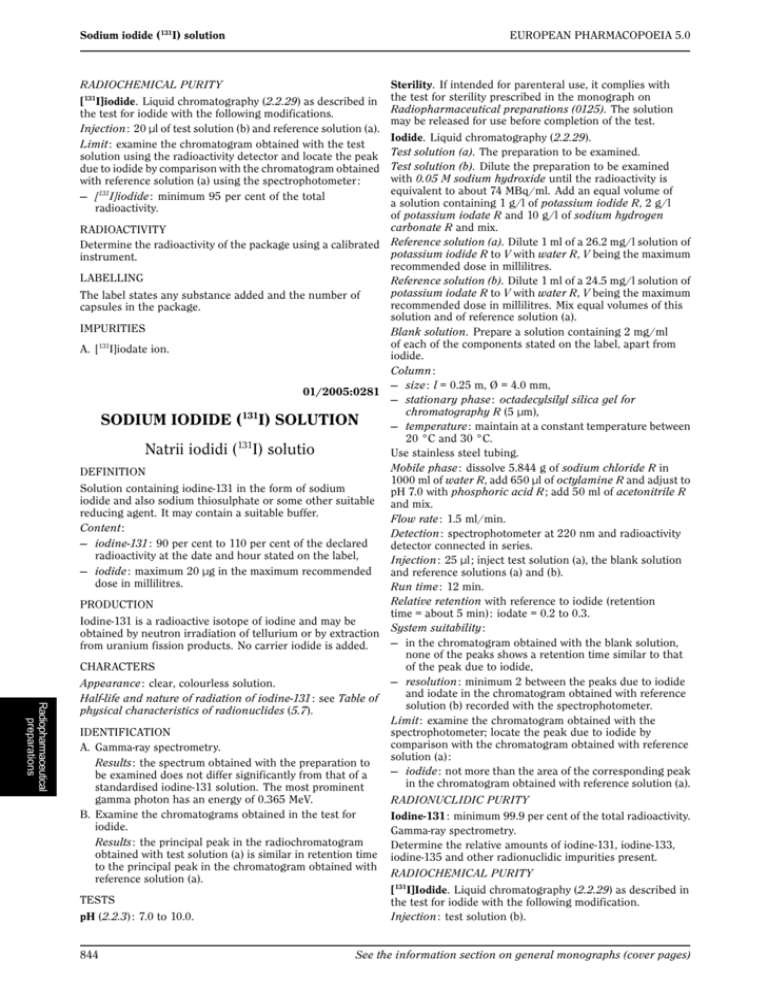
Sodium iodide (131I) solution EUROPEAN PHARMACOPOEIA 5.0 Sterility. If intended for parenteral use, it complies with the test for sterility prescribed in the monograph on Radiopharmaceutical preparations (0125). The solution may be released for use before completion of the test. Iodide. Liquid chromatography (2.2.29). Test solution (a). The preparation to be examined. Test solution (b). Dilute the preparation to be examined with 0.05 M sodium hydroxide until the radioactivity is equivalent to about 74 MBq/ml. Add an equal volume of a solution containing 1 g/l of potassium iodide R, 2 g/l of potassium iodate R and 10 g/l of sodium hydrogen carbonate R and mix. RADIOACTIVITY Determine the radioactivity of the package using a calibrated Reference solution (a). Dilute 1 ml of a 26.2 mg/l solution of potassium iodide R to V with water R, V being the maximum instrument. recommended dose in millilitres. LABELLING Reference solution (b). Dilute 1 ml of a 24.5 mg/l solution of potassium iodate R to V with water R, V being the maximum The label states any substance added and the number of recommended dose in millilitres. Mix equal volumes of this capsules in the package. solution and of reference solution (a). IMPURITIES Blank solution. Prepare a solution containing 2 mg/ml of each of the components stated on the label, apart from 131 A. [ I]iodate ion. iodide. Column : — size : l = 0.25 m, Ø = 4.0 mm, 01/2005:0281 — stationary phase : octadecylsilyl silica gel for chromatography R (5 µm), 131 SODIUM IODIDE ( I) SOLUTION — temperature : maintain at a constant temperature between 20 °C and 30 °C. Natrii iodidi (131I) solutio Use stainless steel tubing. Mobile phase : dissolve 5.844 g of sodium chloride R in DEFINITION 1000 ml of water R, add 650 µl of octylamine R and adjust to Solution containing iodine-131 in the form of sodium pH 7.0 with phosphoric acid R ; add 50 ml of acetonitrile R iodide and also sodium thiosulphate or some other suitable and mix. reducing agent. It may contain a suitable buffer. Flow rate : 1.5 ml/min. Content : Detection : spectrophotometer at 220 nm and radioactivity — iodine-131 : 90 per cent to 110 per cent of the declared detector connected in series. radioactivity at the date and hour stated on the label, Injection : 25 µl ; inject test solution (a), the blank solution — iodide : maximum 20 µg in the maximum recommended and reference solutions (a) and (b). dose in millilitres. Run time : 12 min. Relative retention with reference to iodide (retention PRODUCTION time = about 5 min) : iodate = 0.2 to 0.3. Iodine-131 is a radioactive isotope of iodine and may be obtained by neutron irradiation of tellurium or by extraction System suitability : — in the chromatogram obtained with the blank solution, from uranium fission products. No carrier iodide is added. none of the peaks shows a retention time similar to that CHARACTERS of the peak due to iodide, — resolution : minimum 2 between the peaks due to iodide Appearance : clear, colourless solution. and iodate in the chromatogram obtained with reference Half-life and nature of radiation of iodine-131 : see Table of solution (b) recorded with the spectrophotometer. physical characteristics of radionuclides (5.7). Limit : examine the chromatogram obtained with the IDENTIFICATION spectrophotometer; locate the peak due to iodide by comparison with the chromatogram obtained with reference A. Gamma-ray spectrometry. solution (a) : Results : the spectrum obtained with the preparation to — iodide : not more than the area of the corresponding peak be examined does not differ significantly from that of a in the chromatogram obtained with reference solution (a). standardised iodine-131 solution. The most prominent gamma photon has an energy of 0.365 MeV. RADIONUCLIDIC PURITY B. Examine the chromatograms obtained in the test for Iodine-131 : minimum 99.9 per cent of the total radioactivity. iodide. Gamma-ray spectrometry. Results : the principal peak in the radiochromatogram Determine the relative amounts of iodine-131, iodine-133, obtained with test solution (a) is similar in retention time iodine-135 and other radionuclidic impurities present. to the principal peak in the chromatogram obtained with RADIOCHEMICAL PURITY reference solution (a). [131I]Iodide. Liquid chromatography (2.2.29) as described in TESTS the test for iodide with the following modification. Injection : test solution (b). pH (2.2.3) : 7.0 to 10.0. RADIOCHEMICAL PURITY [131I]iodide. Liquid chromatography (2.2.29) as described in the test for iodide with the following modifications. Injection : 20 µl of test solution (b) and reference solution (a). Limit : examine the chromatogram obtained with the test solution using the radioactivity detector and locate the peak due to iodide by comparison with the chromatogram obtained with reference solution (a) using the spectrophotometer : — [131I]iodide : minimum 95 per cent of the total radioactivity. 844 See the information section on general monographs (cover pages) EUROPEAN PHARMACOPOEIA 5.0 Sodium iodohippurate (123I) injection Limit : examine the chromatogram obtained with the radioactivity detector : — [131I]iodide : minimum 95 per cent of the total radioactivity. RADIOCHEMICAL PURITY [131I]iodide. Liquid chromatography (2.2.29). Test solution. Dilute the preparation to be examined with an equal volume of a solution containing 1 g/l of potassium iodide R, 2 g/l of potassium iodate R and 10 g/l of sodium RADIOACTIVITY hydrogen carbonate R and mix. If necessary, first dilute Measure the radioactivity using suitable equipment by the preparation to be examined with a 2 g/l solution of comparison with a standardised iodine-131 solution or by sodium hydroxide R to ensure that the final mixture has using a calibrated instrument. a radioactivity concentration suitable for the radioactivity detector. LABELLING Reference solution (a). Dissolve 10 mg of potassium The label states : iodide R in water R and dilute to 10 ml with the same solvent. — any substance added, Reference solution (b). Dissolve 20 mg of potassium — the maximum recommended dose, in millilitres, iodate R in water R and dilute to 10 ml with the same solvent. — where applicable, that the preparation is suitable for use Mix equal volumes of this solution and reference solution (a). in the manufacture of parenteral dosage forms. Column : IMPURITIES — size : l = 0.25 m, Ø = 4.0 mm, — stationary phase : octadecylsilyl silica gel for A. [131I]iodate ion. chromatography R (5 µm), 01/2005:2121 — temperature : constant, between 20 °C and 30 °C. Use stainless steel tubing. SODIUM IODIDE (131I) SOLUTION FOR Mobile phase : dissolve 5.85 g of sodium chloride R in 1000 ml of water R, add 0.65 ml of octylamine R and adjust RADIOLABELLING to pH 7.0 with dilute phosphoric acid R ; add 50 ml of acetonitrile R and mix. Natrii iodidi (131I) solutio Flow rate : 1.5 ml/min. ad radio-signandum Detection : spectrophotometer at 220 nm and a radioactivity detector connected in series. DEFINITION Strongly alkaline solution containing iodine-131 in the form Injection : 20 µl. of sodium iodide. It does not contain a reducing agent. Run time : 12 min. Content : 90 per cent to 110 per cent of the declared Relative retention with reference to iodide (retention iodine-131 radioactivity at the date and hour stated on the time = about 5 min) : iodate = 0.2 to 0.3. label. System suitability : reference solution (b) : — resolution : minimum 2 between the peaks due to iodide PRODUCTION and iodate in the chromatogram recorded with the Iodine-131 may be obtained by neutron irradiation of spectrophotometer. tellurium or by extraction from uranium fission products. No Limit : examine the chromatogram obtained with the carrier iodide is added. radioactivity detector : CHARACTERS — [131I]iodide : minimum 95 per cent of the total Appearance : clear, colourless solution. radioactivity. Half-life and nature of radiation of iodine-131 : see Table of RADIOACTIVITY physical characteristics of radionuclides (5.7). Determine the radioactivity using a calibrated instrument. IDENTIFICATION LABELLING A. Gamma-ray spectrometry. The label states : Results : the spectrum obtained with the preparation to be examined does not differ significantly from that of a — the method of production of iodine-131, standardised iodine-131 solution. The most prominent — the vehicle and any substance added, gamma photon of iodine-131 has an energy of 0.365 MeV. — that the preparation is not for direct human use. B. Examine the chromatograms obtained in the test for radiochemical purity (see Tests). IMPURITIES Results : the principal peak in the radiochromatogram A. [131I]iodate ion. obtained with the test solution is similar in retention time to the principal peak in the chromatogram obtained with 01/2005:0564 reference solution (a). TESTS Alkalinity (2.2.4). The preparation is strongly alkaline. RADIONUCLIDIC PURITY Iodine-131 : minimum 99.9 per cent of the total radioactivity. Gamma-ray spectrometry. Determine the relative amounts of iodine-130, iodine-131, iodine-133, iodine-135 and other radionuclidic impurities present. General Notices (1) apply to all monographs and other texts SODIUM IODOHIPPURATE (123I) INJECTION Natrii iodohippurati (123I) solutio iniectabilis DEFINITION Sodium iodohippurate (123I) injection is a sterile solution of sodium (2-[123I]iodobenzamido)acetate. It may contain a suitable buffer and a suitable antimicrobial preservative 845
